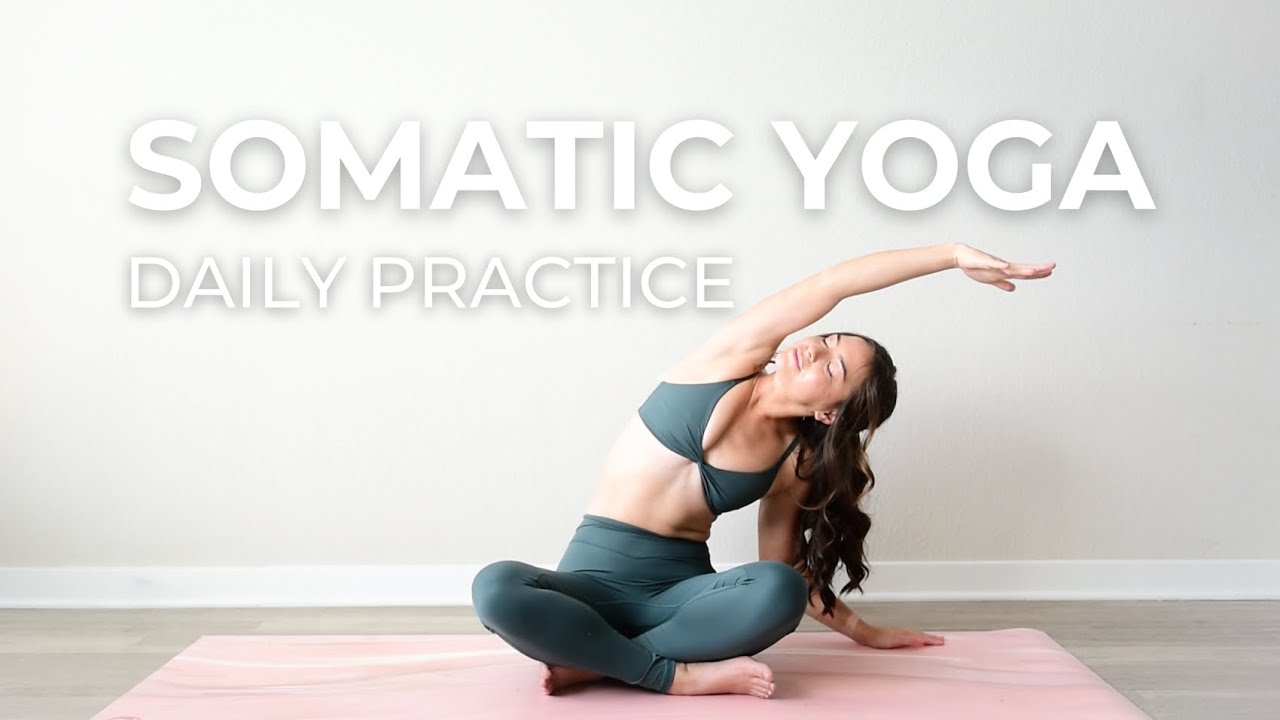Hey there! Today, we’re diving into some somatic yoga for beginners (or for the more experienced folk who just need a refresher).
Somatic yoga is a gentle and aware approach that’s perfect for beginners and seniors alike. It focuses on slow, controlled movements that help you become more aware of your body, making it easier to release tension and improve flexibility without pushing too hard. This friendly style of yoga is all about listening to your body and moving at your own pace, which can be incredibly relaxing and empowering for newcomers to the practice.

- Cat-Cow Flow. Start on your hands and knees, aligning your wrists under your shoulders and knees under your hips. As you inhale, drop your belly, lift your chest and tailbone, and look up gently. Some folks tend to crunch their neck here, so imagine lengthening through the crown of your head instead. On the exhale, round your spine, tucking your chin to chest and tailbone under. People often rush this, but try to move slowly and mindfully, really feeling each vertebra articulate. If your wrists are sensitive, you can do this on your forearms or even seated in a chair.
- Seated Spinal Twist. Sit comfortably on the floor with your legs extended. Bend your right knee and place your right foot on the outside of your left thigh. Place your right hand behind you for support, and bring your left arm to the outside of your right knee. Gently twist to the right, looking over your right shoulder. Many people force the twist, but instead, focus on lengthening your spine with each inhale and gently deepening the twist with each exhale. If sitting on the floor is uncomfortable, you can do this in a chair, keeping both feet on the ground.
- Standing Forward Fold. Stand with your feet hip-width apart, then hinge at your hips to fold forward, letting your upper body hang heavy. Bend your knees generously, it’s a common tendency to lock the knees and strain the lower back. Instead, focus on relaxing your neck and shoulders, letting your head be heavy. If you can’t reach the floor, rest your hands on your shins or grab opposite elbows. the goal isn’t to touch your toes, but to release tension in your back and hamstrings.
- Legs Up the Wall. Lie on your back with your buttocks as close to a wall as comfortable, extending your legs up the wall. Your body should form an L-shape. Many people try to get too close to the wall, which can strain the hamstrings. Instead, adjust your distance so you feel a gentle stretch but no strain. If your legs tire, you can bend your knees or slide your feet down the wall a bit. This is a great pose for relaxation, so close your eyes and focus on deep, slow breaths.
Affirmation: “I am gently awakening my body’s wisdom and strength with each aware movement”
When you’re just starting out with somatic yoga (or any yoga practice for that matter), listen to your body. If something doesn’t feel right, ease off or skip it altogether. No need to push yourself too hard! •
Try to practice at the same time each day, even if it’s just for 10 minutes. It’ll help make it a habit, and you’ll start noticing the benefits sooner.. Don’t forget to breathe! It sounds silly, but focusing on your breath can really enhance your practice and help you relax into those gentle movements. After your session, take a moment to check in with how your body feels. Notice any changes or improvements, no matter how small. It’s a great way to stay motivated and track your progress.
15 Likes
Deepen Your Practice Beyond the Mat
Finding meaningful yoga discussions and guidance can be surprisingly difficult. Discover a space where your questions are welcomed and your growth is celebrated: Start Your Journey
I think this is great! More people could really benefit from even just 10 minutes a day.
To maintain the benefits of somatic yoga, you’ll want to practice consistently (yes, I know, easier said than done when Netflix exists). Even short, daily sessions help reinforce those fancy neural pathways related to body awareness - and by ‘short,’ I mean even those of us who can barely commit to a skincare routine can handle this. Try to set aside a few minutes each day for your routine, preferably before your brain comes up with seventeen creative excuses why tomorrow would be better.
When I first started somatic yoga, wrapping myself in a blanket like a burrito on the floor was incredibly grounding whenever I felt overwhelmed during practice.
It’s such a simple technique but the gentle pressure and warmth really helps reset my nervous system between poses. Now I always keep a soft blanket nearby during my sessions, especially when working through those deeper emotional releases that sometimes come up.
PS: Sometimes the best yoga props are the coziest ones, becoming a human burrito could be so therapeutic.
Bending my knees generously in forward fold instead of keeping them locked makes such a difference, really helps releasing tension in my back!
What really clicked for me was realizing that when I started paying attention to the actual sensations in my body during each pose (rather than just trying to copy the shape), I stopped getting those nagging tweaks and strains that used to pop up.
OH MY GOSH! I just figured out why my jaw has been so tight, I’ve been clenching it during every single pose without even realizing it!
Started doing this thing where I gently open and close my mouth between movements (like a slow-motion yawn) and it’s changing everything. The tension just melts away and suddenly my whole face feels softer. Somatic yoga could fix my TMJ issues.
Somatic yoga is probably not your jam if you’re the type who thinks ‘namaste’ means ‘now must stay buff.’
If your fitness goals involve looking like The Rock or burning enough calories to justify that third slice of pizza (we’ve all been there), you might need to add something with a bit more oomph to your routine. Think of somatic yoga as the chill friend who’s great for deep conversations but won’t help you move a couch.
I’ve been following this soratic flow for a couple of weeks now.
The micro-movements where you barely lift and lower your shoulders while really sensing the gravity pulling them down has been a for my chronic tension. There’s this practice I’ve been following that breaks down these tiny awareness movements so beautifully, especially for those of us who tend to hold stress in our upper body. It’s wild how something so subtle can create such a profound shift in how we carry ourselves throughout the day.
Literally anyone can jump on the somatic yoga train and enjoy the ride which is one of the things I really like about this practice.
Super-fit athletes are getting in on the action - they’re using these thoughtful movement techniques to tune into their bodies better and keep those injuries at bay but even the seniors in my studio are loving this.
I’m cautiously optimistic about introducing somatic yoga to kids. The gentle pace could teach them to listen to their bodies early on, but patience might be required to keep them engaged.
Anyone tried this?
If your hips click during cat-cow, then try making smaller circles instead of the full arch. If morning practice feels stiff, then start with 5 minutes of gentle rocking on your back first.
Small tweaks sometimes have huge payoffs when you listen to your body.

